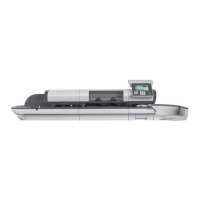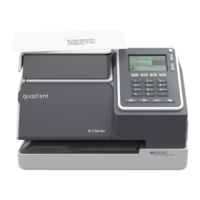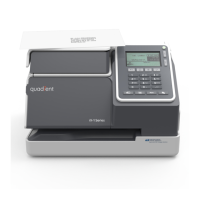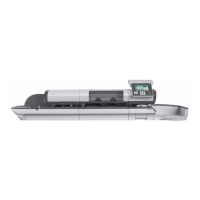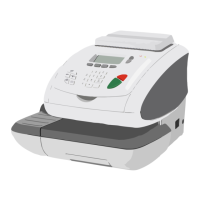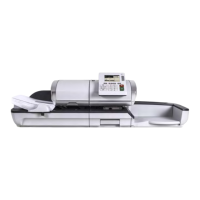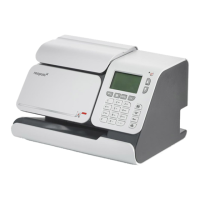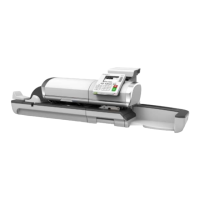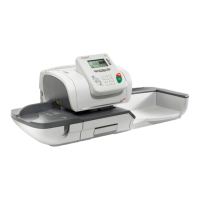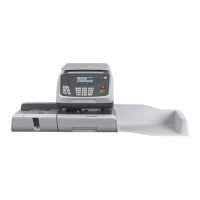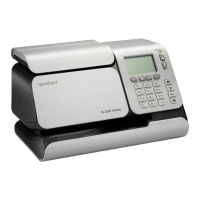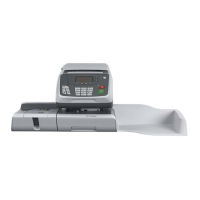Do you have a question about the quadient IX-3 and is the answer not in the manual?
Details power connection requirements, grounding, and safe usage practices.
Step-by-step instructions for safely powering down and disconnecting the mailing system.
Instructions to stop the system immediately in the event of an emergency.
Explanation of symbols used throughout the manual for warnings, notes, and tips.
List of acronyms and their corresponding definitions used in the manual.
Identifies and describes the main physical components of the mailing system.
Details optional accessories like USB keyboard and report printer.
Explains display areas, keys, and shortcuts on the control panel interface.
Identifies and explains the purpose of various system ports and connectors.
Explains Energy Star compliance and system sleep/soft off modes.
Steps to prepare and start a mail processing session, including sorting and login.
Guides on selecting the appropriate imprint type for different mail processes.
Provides practical examples for applying postage to various mail types.
Instructions for setting postage and processing Pre-Paid Imprint mail.
Instructions on how to enter payment surcharge details for reimbursements.
Covers various system settings like account management and rate selection.
Details how to configure imprint elements like date, ERA, and slogan.
Explains how to save, edit, and use job memories for efficient operation.
How to check and add credit to the postage meter.
Procedures for clearing postal inspection messages and unlocking the PSD.
How to set high-value and low-credit warning amounts.
Information on generating and viewing credit history and summary reports.
Overview of tracking postage by account and controlling user access.
Setting up PIN codes to restrict access and credit usage.
Explains different account modes and how to configure them.
Details the process of creating and managing accounts.
How to export and import account lists using a USB memory key.
How to generate and view reports related to account activity.
How to switch between different accounts for mail processing.
How to choose and select postal rates for mail processing.
Procedures for viewing rate tables and downloading new rates.
Steps to generate and display/record various types of reports.
Lists available reports including Account, Credit History, and Daily Usage.
Explains the benefits and features of online services for the mailing system.
Details automatic and manual calls for data upload and feature access.
Guides on performing diagnostic tests for server connectivity.
Overview of services like Ink Management, Rate Protection, and Account upgrades.
How to adjust display contrast and change the language.
How to change sleep and soft-off timeout periods.
How to set high-value and low-credit warning amounts.
Procedures for zeroing the weighing platform and setting GEO code.
How to save, edit, and use job memories for efficient operation.
How to set up postal/online services and LAN parameters.
How to adjust machine time, date, and set automatic date advance.
How to update the mailing system with new options and features.
How to read and delete messages received from the system or customer service.
How to display and load new system options.
How to add, display, modify, delete, and download ERAs.
How to display, delete, and download new PPIs.
How to add, display, modify, delete, and download slogans.
How to view rate tables and download new postal rates.
Procedures for changing, cleaning, and aligning the ink cartridge.
Overview and maintenance of sealing and hand-feed table moisteners.
Procedures for running registration updates and saving customer data.
How to clear mail jams and clean cartridge/moistener brushes.
Guides on performing various diagnostic tests for system components.
How to display software, hardware, machine counters, and event lists.
Details envelope dimensions and weight/thickness limits.
Provides dimensions, weight, and power specifications for the mailing system.
Specifies recommended temperature, humidity, and weighing accuracy conditions.
Information on account limits and weighing accuracy requirements.
| Envelope Feeding | Automatic |
|---|---|
| Weighing Platform | Integrated |
| Connectivity | LAN |
| Display | Touchscreen |
| Folding Types | C-fold, Z-fold, half-fold |
| Weight | 45 kg |
